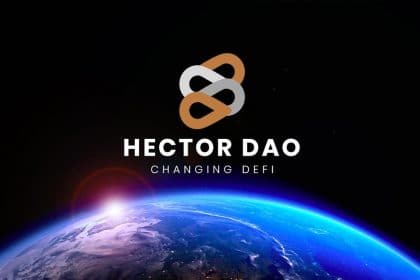Hector DAO Announces a New Website to Incorporate High End Functionalities

Hector Dao, a decentralized protocol based on the $HEC token, has announced a new website scheduled to launch by 9th November. $HEC aims to become the de facto reserve currency on the Fantom network. In order to maintain price stability Hector uses Algorithmic Reserve Currency algorithms and will also be supported by bonds of other decentralized assets.
Today we are moving towards a decentralized world where Bitcoin, Ethereum and other similar Cryptocurrencies continue to disrupt markets while Hector DAO aims to become the de-facto reserve currency. Most of the stablecoins backed by US Dollar aren’t necessarily truly stable as the value of the US Dollar keeps changing, generally falling in value over time. Thus, Hector DAO aims to become a truly stable currency which is backed by existing assets, creating a decentralized protocol which is truly owned by the majority.
The main currency, $HEC, would remain stable in value, and is backed by a mixture of stable and nonstable assets like USDC and FTM itself. The reserve is maintained via liquidity pool fees as well as Bond sales that increase Hector’s treasury revenue. Bonds sales also help the protocol build liquidity and help to control the HEC supply. Hector DAO has been developed to take the idea of decentralization to the next level. $HEC will utilize fractional treasury reserves to attach intrinsic value to its own currency. Hector, becoming an algorithmic reserve currency, will therefore provide free floating value.
Hector DAO Will Change the Meaning of Stablecoins
Stablecoins play a critical role in the crypto market where earlier it was seen as an on-boarding tool for traders to start using crypto assets, but it has increasingly grown to become a key liquidity provider for the market as well. The majority of popular crypto tokens are paired against stablecoins like USDT for trading. However, as the market size has increased, so has the complexities behind stablecoin issuance. Tether, currently the top stablecoin issuer with over $60 billion in circulation has been on the radars of regulatory agencies due to the opaque management of funds and obscurity around the backing of USDT tokens. Centralized stablecoin issuers like Tether could face the wrath of regulators any day and might vanish altogether. This is where Hector DAO could take over and become the default reserve currency.
The face-value of HEC will ultimately be determined by the market. If buying pressure is high, the price rises. If selling pressure is high, the price falls. The focus of each investor will rely upon the way in which the investor interacts with the protocol. Thus, this would make it impossible to artificially manipulate the market as Tether is often accused of.
In traditional markets, price action is the determining factor of value, however this is less prominent with HEC since stakers’ equity will increase over time, creating a steadily falling cost basis. Therefore HEC balance is more important than face-value price. Stakers care more about longer-term growth than immediate price action since the protocol dictates a price floor for HEC tokens of 1 DAI plus a market-determined premium.
How Hector Dao Functions?
Hector DAO’s native reserve currency HEC would be a gamechanger in the market, especially at a time when the governments around the globe are cracking the whip on centralized stablecoins. The US government is already planning to issue regulations, while the likes of Tether continue to function in uncertainty. At the start the token value of HEC will certainly be volatile, but the lucrative staking rewards seem to be an attractive prospect for investors. This in turn will bring in more investors seeking wealth creation, which increases demand further. This will create a feedback loop leading to the expansion of the DAO and an increasing HEC price. Expansionary periods also allow the DAO to increase the liquidity held in its reserves.
In periods of low demand, staking and bonding rewards will also fall. This is a natural part of price action – nobody in the Cryptocurrency space is a stranger to falling prices. When prices fall far enough, the protocol will use its reserves to buy HEC and stabilise it. Given that this reserve intervention is a certainty, risk falls as the price falls since buying volume is anticipated.
One must not confuse HEC with a stablecoin, it is more of a reserve currency that aims to attain a stable value overtime to replace the current generation of centralized US Dollar backed stablecoins. Once HEC is staked, staker’s balance will increase with the circulating supply, meaning, even if someone misses out on a lower price, their HEC balance will increase due to the staking protocol. Therefore, users will be generating a staking income, reducing your risk, even at a higher price.
To learn more about The Hector DAO visit the website.
Social links: Twitter, Telegram, Instagram, Discord, Reddit, GitHub, Docs, YouTube.
Disclaimer: This publication is sponsored. Coinspeaker does not endorse or assume responsibility for the content, accuracy, quality, advertising, products, or other materials on this web page. Readers are advised to conduct their own research before engaging with any company mentioned. Please note that the featured information is not intended as, and shall not be understood or construed as legal, tax, investment, financial, or other advice. Nothing contained on this web page constitutes a solicitation, recommendation, endorsement, or offer by Coinspeaker or any third party service provider to buy or sell any cryptoassets or other financial instruments. Crypto assets are a high-risk investment. You should consider whether you understand the possibility of losing money due to leverage. None of the material should be considered as investment advice. Coinspeaker shall not be held liable, directly or indirectly, for any damages or losses arising from the use or reliance on any content, goods, or services featured on this web page.